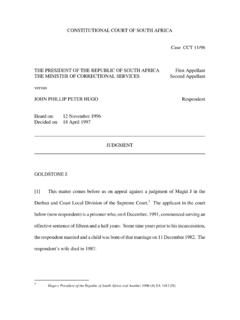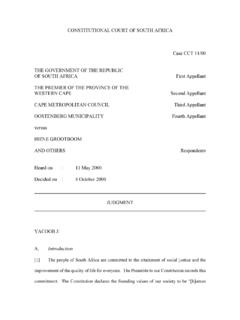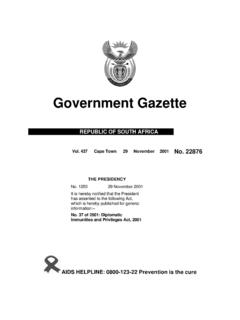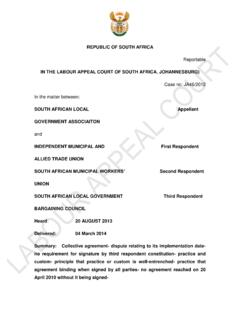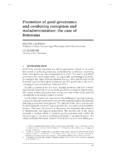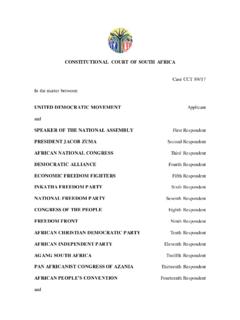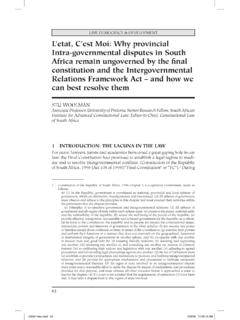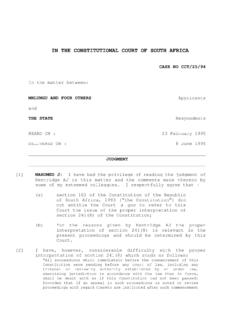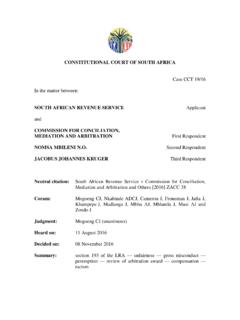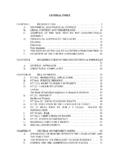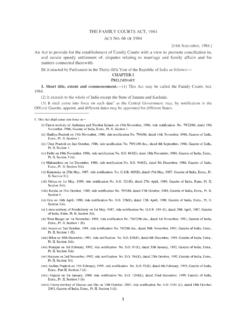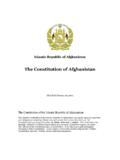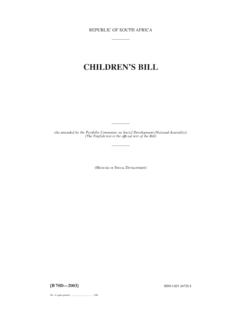Transcription of Case CCT 47/04 AHMED RAFFIK OMAR Applicant …
1 CONSTITUTIONAL COURT OF SOUTH AFRICA Case CCT 47/ 04 ahmed raffik omar applicant versus THE government OF THE republic OF SOUTH AFRICA First Respondent THE MINISTER OF JUSTICE AND CONSTITUTIONAL DEVELOPMENT Second Respondent HALIMA JOOSAB Third Respondent THE COMMISSION FOR GENDER EQUALITY Amicus Curiae Heard on : 5 May 2005 Decided on : 7 November 2005 JUDGMENT VAN DER WESTHUIZEN J: Introduction and factual background [1] The Domestic Violence Act 116 of 1998 (the Act) provides for the issue of protection orders to help victims of domestic violence.
2 Section 81 of the Act provides for a court to authorise a warrant of arrest when it issues a protection order, but for the 1 The scheme of the Act and the role of section 8 are dealt with below from para 20 onwards. The wording of section 8 appears in para 27. VAN DER WESTHUIZEN J 2 warrant to be suspended on condition that there is no breach of the terms of the protection order. This matter deals with the constitutionality of section 8, measured against the rights to freedom and security of the person, a fair trial and access to courts, as protected in the Constitution.
3 [2] Mr AHMED RAFFIK Omar, the Applicant , unsuccessfully applied to the High Court in Pietermaritzburg to have section 8 declared He now applies for leave to appeal against the judgment and order of the High Court. [3] According to the High Court judgment the application arose out of an abusive relationship between the Applicant and Ms Halima Joosab, the third respondent. They were married to each other according to Islamic law, but became estranged from one another. Several protection orders were issued against the Applicant in terms of the Act. [4] This application was sparked by proceedings regarding one of these During the hearing in the Durban Magistrates Court on the return day of an interim protection order, the parties both represented by their attorneys agreed to a draft order, which the court made the final order.
4 In terms of the order the Applicant was, amongst other things, prohibited from threatening, assaulting, harassing, intimidating, 2 See AHMED RAFFIK Omar v The government of South Africa and Others case number 3501/03, unreported. 3 The order was issued under case number 113/2003. Another order under case number 143/2003, which the third respondent s father had obtained in the Durban Magistrates Court against the Applicant in terms of the Act, was set aside on the return date. An order under case number 880/2003, which the third respondent s father secured against the Applicant in the Verulam Magistrates Court, was discharged.
5 VAN DER WESTHUIZEN J 3 stalking or abusing the third respondent or their children. The Applicant was furthermore ordered not to enter the third respondent s residence, nor to communicate with her except with regard to the children, to provide her with the use of a vehicle and to pay a monthly amount to her in respect of emergency monetary relief. The order also granted the Applicant reasonable access to the children. [5] A suspended warrant of arrest was annexed to the court order in terms of section 8(1) of the Act. When the terms of the order were allegedly breached, the warrant was executed, but subsequently suspended.
6 The Applicant then approached the High Court for relief. [6] After the High Court application had been struck off the roll, and after an application for direct access to this Court had been dismissed for a number of reasons, including that the Applicant should first approach the High Court,4 the High Court heard the application. The Applicant sought an order declaring section 8 of the Act invalid. Tshabalala JP dismissed the [7] The application for leave to appeal is opposed by the third respondent, as is the appeal. The third respondent applies for condonation for the late filing of papers in 4 In Ex Parte Omar 2003 (10) BCLR 1087 (CC), this Court found that the constitutionality of section 8 of the Act was a matter of constitutional significance, but that the exceptional circumstances required for the grant of direct access did not exist, and that the Applicant was entitled to and should re-enrol the application in the High Court.
7 The Applicant s refusal to comply with the rules of this Court was a contributing factor to this Court s order. 5 The order as well as the last paragraph of the High Court s judgment erroneously refers to section 12(8) instead of section 8 of the Act. VAN DER WESTHUIZEN J 4 response to the application. The third respondent has an obvious interest in the matter and could contribute to the deliberation of the important questions raised. She provides an acceptable explanation for the relatively short delay. The Applicant would not be prejudiced by the granting of condonation. Therefore condonation is granted.
8 [8] The government and the Department of Justice, the first and second respondents, do not oppose the application for leave to appeal. However, they oppose the appeal in the event of leave being granted. The Commission for Gender Equality applied to be admitted to the proceedings as amicus curiae, was admitted and made submissions on the appeal, but not on the application for leave to [9] The Applicant also seeks condonation for his non-compliance with the rules relating to form, time and service. His explanation is that he was under the wrong impression that he needed a certificate from the High Court.
9 Whether to grant or refuse condonation depends not only on the explanation offered, but also on the prospects of success of the Applicant s case. The question of condonation is thus returned to later in this judgment. [10] The Applicant raises several objections regarding section 8 and related provisions of the Act. It would be useful to gain an understanding of the social 6 In terms of section 187 of the Constitution, the Commission, as one of the state institutions supporting constitutional democracy recognised in chapter 9, must promote respect for gender equality and the protection, development and attainment of gender equality.
10 The Commission is referred to in the Constitution and therefore in this judgment as the Commission for Gender Equality , even though its website and letterhead indicate its name as the Commission on Gender Equality . The submissions of the first and second respondents and the amicus also apply to the issues to be resolved regarding the application for leave to appeal, and not only to the appeal. VAN DER WESTHUIZEN J 5 context and purpose as well as the scheme and contents of the Act, before considering the Applicant s objections. The context of the Act [11] The context and purpose of the Act are stated in its preamble: RECOGNISING that domestic violence is a serious social evil; that there is a high incidence of domestic violence within South African society; that victims of domestic violence are among the most vulnerable members of society; that domestic violence takes on many forms; that acts of domestic violence may be committed in a wide range of domestic relationships; and that the remedies currently available to the victims of domestic violence have proved to be ineffective.
